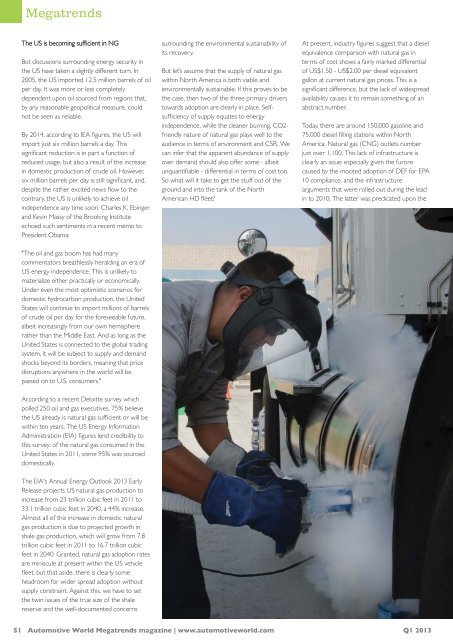megatrends
megatrends
megatrends
You also want an ePaper? Increase the reach of your titles
YUMPU automatically turns print PDFs into web optimized ePapers that Google loves.
Megatrends<br />
The US is becoming sufficient in NG<br />
But discussions surrounding energy security in<br />
the US have taken a slightly different turn. In<br />
2005, the US imported 12.5 million barrels of oil<br />
per day. It was more or less completely<br />
dependent upon oil sourced from regions that,<br />
by any reasonable geopolitical measure, could<br />
not be seen as reliable.<br />
By 2014, according to IEA figures, the US will<br />
import just six million barrels a day. This<br />
significant reduction is in part a function of<br />
reduced usage, but also a result of the increase<br />
in domestic production of crude oil. However,<br />
six million barrels per day is still significant, and,<br />
despite the rather excited news flow to the<br />
contrary, the US is unlikely to achieve oil<br />
independence any time soon. Charles K. Ebinger<br />
and Kevin Massy of the Brooking Institute<br />
echoed such sentiments in a recent memo to<br />
President Obama:<br />
"The oil and gas boom has had many<br />
commentators breathlessly heralding an era of<br />
US energy independence. This is unlikely to<br />
materialize either practically or economically.<br />
Under even the most optimistic scenarios for<br />
domestic hydrocarbon production, the United<br />
States will continue to import millions of barrels<br />
of crude oil per day for the foreseeable future,<br />
albeit increasingly from our own hemisphere<br />
rather than the Middle East. And as long as the<br />
United States is connected to the global trading<br />
system, it will be subject to supply and demand<br />
shocks beyond its borders, meaning that price<br />
disruptions anywhere in the world will be<br />
passed on to U.S. consumers."<br />
According to a recent Deloitte survey which<br />
polled 250 oil and gas executives, 75% believe<br />
the US already is natural gas sufficient or will be<br />
within ten years. The US Energy Information<br />
Administration (EIA) figures lend credibility to<br />
this survey: of the natural gas consumed in the<br />
United States in 2011, some 95% was sourced<br />
domestically.<br />
The EIA's Annual Energy Outlook 2013 Early<br />
Release projects US natural gas production to<br />
increase from 23 trillion cubic feet in 2011 to<br />
33.1 trillion cubic feet in 2040, a 44% increase.<br />
Almost all of this increase in domestic natural<br />
gas production is due to projected growth in<br />
shale gas production, which will grow from 7.8<br />
trillion cubic feet in 2011 to 16.7 trillion cubic<br />
feet in 2040. Granted, natural gas adoption rates<br />
are miniscule at present within the US vehicle<br />
fleet, but that aside, there is clearly some<br />
headroom for wider spread adoption without<br />
supply constraint. Against this, we have to set<br />
the twin issues of the true size of the shale<br />
reserve and the well-documented concerns<br />
surrounding the environmental sustainability of<br />
its recovery.<br />
But let’s assume that the supply of natural gas<br />
within North America is both viable and<br />
environmentally sustainable. If this proves to be<br />
the case, then two of the three primary drivers<br />
towards adoption are clearly in place. Selfsufficiency<br />
of supply equates to energy<br />
independence, while the cleaner burning, CO2friendly<br />
nature of natural gas plays well to the<br />
audience in terms of environment and CSR. We<br />
can infer that the apparent abundance of supply<br />
over demand should also offer some - albeit<br />
unquantifiable - differential in terms of cost too.<br />
So what will it take to get the stuff out of the<br />
ground and into the tank of the North<br />
American HD fleet?<br />
At present, industry figures suggest that a diesel<br />
equivalence comparison with natural gas in<br />
terms of cost shows a fairly marked differential<br />
of US$1.50 - US$2.00 per diesel equivalent<br />
gallon at current natural gas prices. This is a<br />
significant difference, but the lack of widespread<br />
availability causes it to remain something of an<br />
abstract number.<br />
Today, there are around 150,000 gasoline and<br />
75,000 diesel filling stations within North<br />
America. Natural gas (CNG) outlets number<br />
just over 1,100. This lack of infrastructure is<br />
clearly an issue: especially given the furore<br />
caused by the mooted adoption of DEF for EPA<br />
10 compliance, and the infrastructure<br />
arguments that were rolled out during the lead<br />
in to 2010. The latter was predicated upon the<br />
51 Automotive World Megatrends magazine | www.automotiveworld.com Q1 2013


